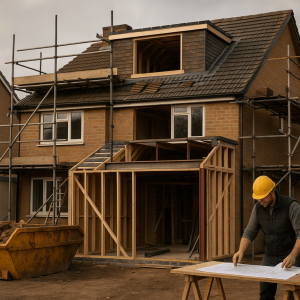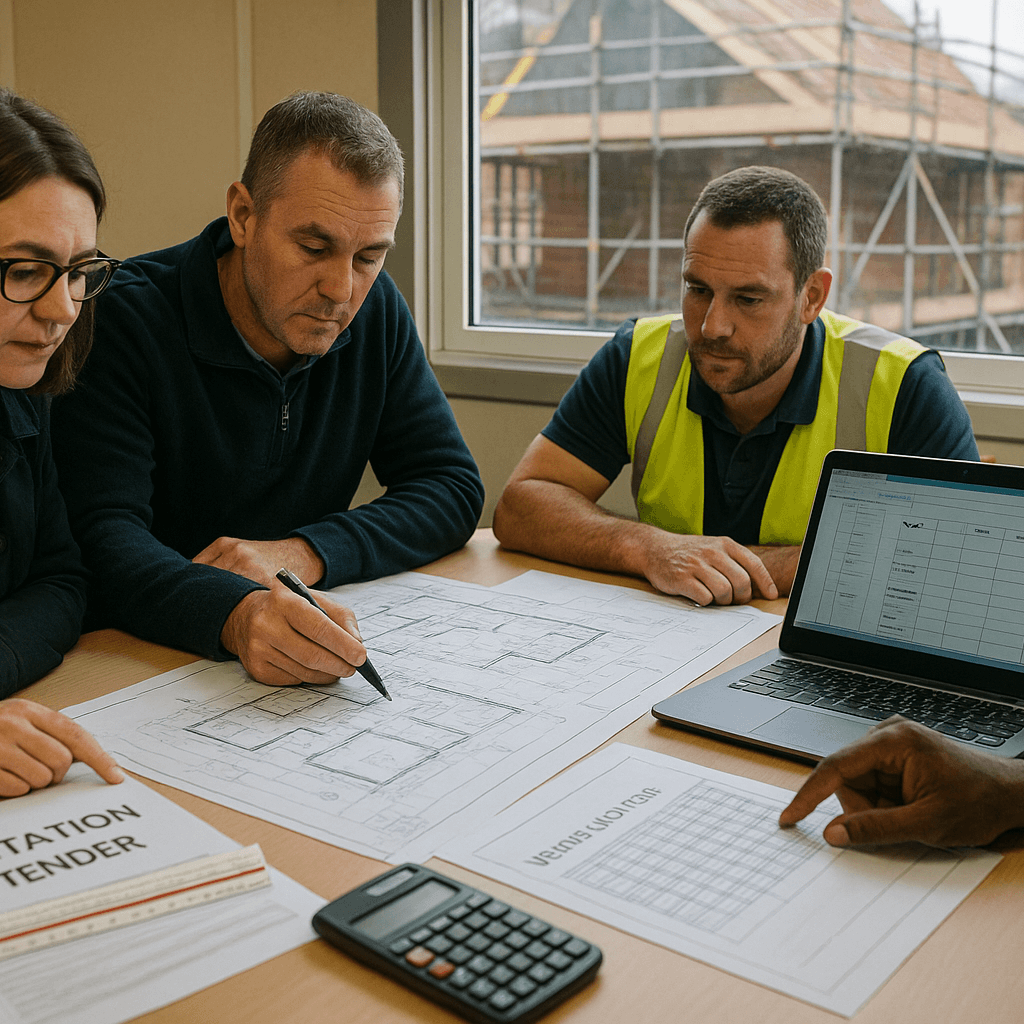Construction estimating is a cornerstone of the building industry, serving as a blueprint for financial management from project inception to completion. It involves meticulous calculation of both direct and indirect costs such as materials, wages, equipment depreciation, and more. Professional construction estimators are pivotal to this process, ensuring that both contractors and owners can navigate the financial landscape of construction projects effectively.
Accurate Construction Estimating
Why is precise construction estimating imperative? It forms the bedrock of project feasibility and profitability, supporting all parties involved to make informed decisions. Are you aware that inaccuracies can either inflate costs or squeeze margins, putting the entire project at risk? Let’s peel back the layers and understand this intricate discipline.
Early Stages: The Foundation of Estimating
Every estimate begins with a comprehensive review of bid packages which include contracts, conditions, and detailed specifications. Estimators meticulously assess every element, ensuring nothing is overlooked.
Site Analysis: More Than Just a Glance
A thorough site visit is more than a mere formality. It gives estimators valuable insights into potential challenges that could affect the project costs, from ground conditions to accessibility issues.
Finding the Nuts and Bolts: Material and Labor Evaluation
After the site review, estimators embark on what is known as a ‘material takeoff’. This stage is vital as it catalogs every required material, determining the need from nuts and bolts to significant quantities of concrete. But it doesn’t stop there; labor needs are also scrutinized, ensuring every aspect of manpower—from skilled tradespeople to general labor—is precisely calculated.
Negotiating the Best Deals: Engaging with Suppliers
Now, armed with exhaustive lists of materials and a clear understanding of labor requirements, estimators outreach to suppliers and vendors. The aim here is to secure the most cost-effective deals, keeping in mind factors like bulk pricing and the longevity of quotes.
The Hidden Figures: Calculating Indirect Costs and Overheads
Beyond the obvious expenses lie the indirect costs and overheads. From insurance and bonding to the nuts and bolts of managing an office, these are equally crucial for a comprehensive budget.
Wrapping It Up: Profit Margins and Contingencies
Finally, estimators ensure that there is a clear calculation for both a healthy profit margin and a sensible contingency. After all, no project is without its surprises, and preparing for the unexpected is a hallmark of robust estimating practices.
Technological Integration: Estimating Software
In the digital age, construction estimating software plays a pivotal role. It not only speeds up the process but also enhances accuracy, allowing estimators to focus more on strategic aspects rather than getting bogged down with manual calculations.
A Data-Driven Future in Construction Estimating
A progressive approach to construction estimating, driven by historical data and detailed analytics, sets the stage for long-term profitability and growth. This data-centric methodology ensures estimates are not just numbers but strategic tools that enhance competitive advantage and project success.
Understanding Construction Estimating Software
Today’s construction estimating software is far more advanced than simple spreadsheets. These platforms integrate various functionalities, including cost databases, automated takeoff tools, and project management features. Software like Cost Estimator, Sage Estimating, and Buildertrend streamline the process, offering real-time updates and collaboration features that enhance the efficiency and accuracy of estimates.
The Role of Historical Data in Estimating
Historical data plays a critical role in refining estimates. By analysing past project costs, estimators can identify patterns and benchmarks that inform future estimates. This data helps in adjusting for inflation, regional cost variations, and changes in material prices, leading to more accurate and reliable estimates.
The Human Element: Skilled Estimators
While technology is a powerful ally, the expertise of skilled estimators remains irreplaceable. Their ability to interpret data, foresee potential challenges, and make informed judgments is crucial. Estimators with a deep understanding of construction processes, market trends, and client requirements bring invaluable insights to the table.
Sustainable Practices in Construction Estimating
Incorporating sustainability into construction estimating is becoming increasingly important. Estimators now consider the environmental impact of materials and processes. Sustainable estimating involves selecting eco-friendly materials, reducing waste, and implementing energy-efficient practices. This not only benefits the environment but can also lead to cost savings in the long run.
Training and Certification for Construction Estimators
Professional development is key for estimators to stay current with industry standards and advancements. Various certifications, such as those from the Chartered Institute of Building (CIOB) and the Royal Institution of Chartered Surveyors (RICS), provide formal recognition of expertise and commitment to ethical practices.
Challenges in Construction Estimating
Estimators face several challenges, including fluctuating material prices, labour shortages, and regulatory changes. Staying adaptable and informed is essential to overcome these hurdles. Regular training, continuous learning, and networking within the industry help estimators stay ahead of these challenges.
The Importance of Communication in Estimating
Effective communication is vital throughout the estimating process. Estimators must liaise with architects, engineers, suppliers, and clients to gather accurate information and ensure all aspects of the project are considered. Clear communication helps in preventing misunderstandings and errors that could lead to cost overruns.
Risk Management in Construction Estimating
Risk management is an integral part of construction estimating. Identifying potential risks and incorporating mitigation strategies into the estimate ensures the project remains on track financially. This includes analysing site conditions, assessing supply chain stability, and preparing for unforeseen events.
Conclusion
In essence, mastering construction estimating is about much more than just crunching numbers. It’s a strategic endeavour that combines analytical thinking, market awareness, and technological prowess. For those looking to excel in the construction industry, embracing these practices is not just beneficial; it’s essential.
Frequently Asked Questions
What is construction estimating? Construction estimating is the process of calculating the total costs involved in a construction project. This includes both direct costs like materials and labour and indirect costs such as equipment depreciation and office salaries.
Why is accurate estimating important in construction? Accurate estimating ensures that the project can be completed within the budget, making it feasible and profitable for contractors and owners alike.
What are some common tools used in construction estimating? Apart from traditional methods like manual takeoffs, digital tools such as construction estimating software are widely used due to their efficiency and accuracy.
How does site condition affect construction estimating? Site conditions can massively impact the cost due to factors like accessibility, soil conditions, and proximity to resources, thus influencing the overall estimate.
What is the role of contingency in estimates? Contingency is a budget set aside for unforeseen circumstances that might cause cost overruns, ensuring the project remains financially viable even when surprises occur.
What is the impact of technology on construction estimating? Technology, especially estimating software, has refined the accuracy and efficiency of construction estimating, allowing for more precise calculations and easier adjustments.
Can anyone become a construction estimator? While anyone can learn estimating techniques, professional estimators often have background in construction management, civil engineering, or related fields alongside significant experience in the industry.
What are the future trends in construction estimating? Future trends point towards more integration of AI and machine learning, allowing for even more precise estimates and streamlined processes.
What qualifications are needed for a construction estimator? Qualifications typically include a degree in construction management, civil engineering, or a related field, alongside certifications from professional bodies like the CIOB or RICS.
How do estimators deal with fluctuating material prices? Estimators deal with fluctuating material prices by using historical data, market analysis, and establishing relationships with suppliers to get the best deals and insights into future price trends.
What is a material takeoff in construction estimating? A material takeoff is a detailed listing of all materials required for a construction project, used to calculate the quantities and costs involved.
How do construction estimators use historical data? Historical data helps estimators predict future costs based on past project experiences, adjust for inflation, and identify cost patterns and trends.
What role does sustainability play in construction estimating? Sustainability in construction estimating involves selecting eco-friendly materials and processes, reducing waste, and incorporating energy-efficient practices to minimise environmental impact.
What are indirect costs in construction estimating? Indirect costs include expenses not directly tied to physical construction work, such as administrative costs, insurance, permits, and equipment depreciation.
How important is communication in construction estimating? Communication is crucial in construction estimating to gather accurate information, ensure all project aspects are considered, and prevent misunderstandings that could lead to cost overruns.











